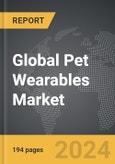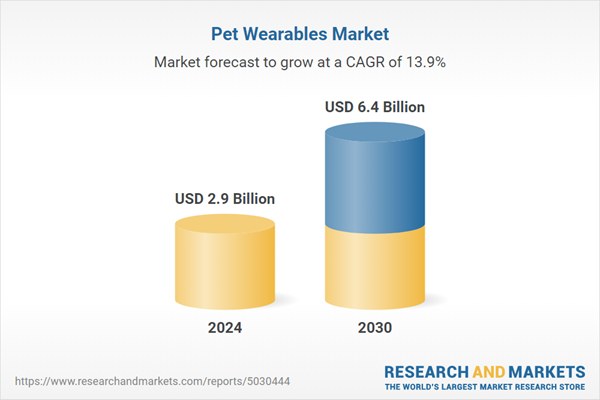The global market for Pet Wearables was valued at US$2.9 Billion in 2024 and is projected to reach US$6.4 Billion by 2030, growing at a CAGR of 13.9% from 2024 to 2030. This comprehensive report provides an in-depth analysis of market trends, drivers, and forecasts, helping you make informed business decisions. The report includes the most recent global tariff developments and how they impact the Pet Wearables market.
Segments: Technology (GPS, RFID, Sensors, Other Technologies); Application (Identification & Tracking, Facilitation, Safety & Security, Behavior Monitoring & Control, Other Applications).
Geographic Regions/Countries: World; United States; Canada; Japan; China; Europe (France; Germany; Italy; United Kingdom; and Rest of Europe); Asia-Pacific; Rest of World.
The analysts continuously track trade developments worldwide, drawing insights from leading global economists and over 200 industry and policy institutions, including think tanks, trade organizations, and national economic advisory bodies. This intelligence is integrated into forecasting models to provide timely, data-driven analysis of emerging risks and opportunities.
Global Pet Wearables Market - Key Trends and Drivers Summarized
Exploring the Future of Pet Care: The Rise of Pet Wearables
Pet wearables are cutting-edge devices designed to monitor and enhance the health and well-being of pets. These gadgets include GPS trackers, activity monitors, health monitoring devices, and even smart collars that can perform multiple functions. GPS trackers are primarily used to keep tabs on a pet’s location, providing peace of mind to owners and helping reunite lost pets with their families. Activity monitors, akin to fitness trackers for humans, track a pet’s movements, rest patterns, and exercise levels, offering insights into their overall health and fitness. Health monitoring devices can measure vital signs, such as heart rate and body temperature, alerting owners to potential health issues. Smart collars often integrate these functionalities, providing a comprehensive tool for managing a pet’s lifestyle and health needs. These wearables typically connect to smartphone apps, allowing pet owners to access and analyze data in real time.How Are Technological Advancements Enhancing Pet Wearables?
Technological advancements are at the forefront of the pet wearables revolution, driving the development of more sophisticated and effective devices. Advances in miniaturization have allowed for the creation of lightweight, comfortable wearables that do not impede a pet’s movement or comfort. Enhanced battery life and energy-efficient designs ensure that these devices can operate for extended periods without frequent recharging. The integration of advanced sensors and machine learning algorithms enables more accurate tracking and analysis of a pet’s activities and health metrics. Additionally, the advent of IoT (Internet of Things) technology has facilitated seamless connectivity between pet wearables and various smart home devices, creating a cohesive ecosystem for pet care. Wearables equipped with AI capabilities can now predict and alert owners to potential health issues based on behavioral patterns, offering a proactive approach to pet health management.What Role Do Pet Wearables Play in Ensuring Pet Safety?
Pet wearables play a crucial role in enhancing pet safety, providing tools and technologies that help prevent accidents and improve emergency response. GPS trackers are particularly valuable for their ability to provide real-time location data, reducing the risk of pets getting lost and enabling swift recovery if they wander off. Activity monitors can detect unusual behavior patterns that might indicate distress or illness, prompting timely interventions. Some wearables are equipped with geofencing capabilities, which allow owners to set safe boundaries for their pets; an alert is sent if the pet breaches these boundaries, helping to prevent accidents or escapes. In multi-pet households, wearables can also help manage and monitor interactions between pets, ensuring harmonious coexistence. Additionally, wearables that monitor environmental factors, such as temperature and humidity, can help prevent heatstroke or hypothermia, especially in extreme weather conditions, ensuring pets remain safe and comfortable.What Factors Are Driving Growth in the Pet Wearables Market?
The growth in the pet wearables market is driven by several factors. Firstly, the increasing pet ownership rates globally and the rising trend of treating pets as family members are leading to higher spending on advanced pet care products. Technological advancements, including improvements in sensor technology, battery life, and AI integration, are making wearables more functional and user-friendly, thereby increasing their adoption. The expanding applications of pet wearables, from fitness tracking to health monitoring and safety, are broadening their appeal. Additionally, the growth of the IoT ecosystem has facilitated better connectivity and data management, enhancing the overall user experience. The rise of e-commerce platforms has made it easier for consumers to access a wide variety of pet wearables, further boosting market growth. Furthermore, increased awareness of pet health and wellness is prompting owners to invest in devices that can help them monitor and maintain their pets’ well-being. Lastly, collaborations between tech companies and veterinary professionals are driving innovation, ensuring that new products meet the practical needs of pet health management.Report Scope
The report analyzes the Pet Wearables market, presented in terms of units. The analysis covers the key segments and geographic regions outlined below.Segments: Technology (GPS, RFID, Sensors, Other Technologies); Application (Identification & Tracking, Facilitation, Safety & Security, Behavior Monitoring & Control, Other Applications).
Geographic Regions/Countries: World; United States; Canada; Japan; China; Europe (France; Germany; Italy; United Kingdom; and Rest of Europe); Asia-Pacific; Rest of World.
Key Insights:
- Market Growth: Understand the significant growth trajectory of the GPS segment, which is expected to reach US$2.6 Billion by 2030 with a CAGR of a 13.4%. The RFID segment is also set to grow at 15.9% CAGR over the analysis period.
- Regional Analysis: Gain insights into the U.S. market, valued at $791.1 Million in 2024, and China, forecasted to grow at an impressive 12.8% CAGR to reach $966.0 Million by 2030. Discover growth trends in other key regions, including Japan, Canada, Germany, and the Asia-Pacific.
Why You Should Buy This Report:
- Detailed Market Analysis: Access a thorough analysis of the Global Pet Wearables Market, covering all major geographic regions and market segments.
- Competitive Insights: Get an overview of the competitive landscape, including the market presence of major players across different geographies.
- Future Trends and Drivers: Understand the key trends and drivers shaping the future of the Global Pet Wearables Market.
- Actionable Insights: Benefit from actionable insights that can help you identify new revenue opportunities and make strategic business decisions.
Key Questions Answered:
- How is the Global Pet Wearables Market expected to evolve by 2030?
- What are the main drivers and restraints affecting the market?
- Which market segments will grow the most over the forecast period?
- How will market shares for different regions and segments change by 2030?
- Who are the leading players in the market, and what are their prospects?
Report Features:
- Comprehensive Market Data: Independent analysis of annual sales and market forecasts in US$ Million from 2024 to 2030.
- In-Depth Regional Analysis: Detailed insights into key markets, including the U.S., China, Japan, Canada, Europe, Asia-Pacific, Latin America, Middle East, and Africa.
- Company Profiles: Coverage of players such as Actijoy, Dairymaster USA Inc., FitBark Inc., Garmin International, Inc., Hachiko and more.
- Complimentary Updates: Receive free report updates for one year to keep you informed of the latest market developments.
Some of the 42 companies featured in this Pet Wearables market report include:
- Actijoy
- Dairymaster USA Inc.
- FitBark Inc.
- Garmin International, Inc.
- Hachiko
- IceRobotics Ltd.
- Kippy
- Link AKC
- Nedap N.V.
- Nuzzles & Co.
Tariff Impact Analysis: Key Insights for 2025
Global tariff negotiations across 180+ countries are reshaping supply chains, costs, and competitiveness. This report reflects the latest developments as of April 2025 and incorporates forward-looking insights into the market outlook.The analysts continuously track trade developments worldwide, drawing insights from leading global economists and over 200 industry and policy institutions, including think tanks, trade organizations, and national economic advisory bodies. This intelligence is integrated into forecasting models to provide timely, data-driven analysis of emerging risks and opportunities.
What’s Included in This Edition:
- Tariff-adjusted market forecasts by region and segment
- Analysis of cost and supply chain implications by sourcing and trade exposure
- Strategic insights into geographic shifts
Buyers receive a free July 2025 update with:
- Finalized tariff impacts and new trade agreement effects
- Updated projections reflecting global sourcing and cost shifts
- Expanded country-specific coverage across the industry
Table of Contents
I. METHODOLOGYII. EXECUTIVE SUMMARY2. FOCUS ON SELECT PLAYERSIII. MARKET ANALYSISIV. COMPETITION
1. MARKET OVERVIEW
3. MARKET TRENDS & DRIVERS
4. GLOBAL MARKET PERSPECTIVE
UNITED STATES
CANADA
JAPAN
CHINA
EUROPE
FRANCE
GERMANY
ITALY
UNITED KINGDOM
REST OF EUROPE
ASIA-PACIFIC
REST OF WORLD
Companies Mentioned (Partial List)
A selection of companies mentioned in this report includes, but is not limited to:
- Actijoy
- Dairymaster USA Inc.
- FitBark Inc.
- Garmin International, Inc.
- Hachiko
- IceRobotics Ltd.
- Kippy
- Link AKC
- Nedap N.V.
- Nuzzles & Co.
Table Information
| Report Attribute | Details |
|---|---|
| No. of Pages | 146 |
| Published | April 2025 |
| Forecast Period | 2024 - 2030 |
| Estimated Market Value ( USD | $ 2.9 Billion |
| Forecasted Market Value ( USD | $ 6.4 Billion |
| Compound Annual Growth Rate | 13.9% |
| Regions Covered | Global |









